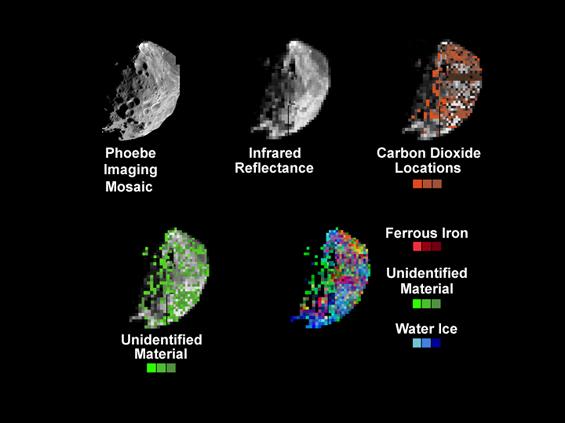Phoebe’s Mineral Distribution

| PIA Number | PIA06400 |
|---|---|
| Language |
|
Phoebe's Mineral Distribution June 23, 2004 | |
These set of images were created during the Phoebe flyby on June 11, 2004. The images show the location and distribution of water-ice, ferric iron, carbon dioxide and an unidentified material on the tiny moon of Saturn. The first image was taken with Cassini's narrow angle camera and is shown for comparison purposes only. The other images were taken by the visual and infrared mapping spectrometer onboard Cassini. | |
The existence of carbon dioxide strongly suggests that Phoebe did not originate in the asteroid belt, but rather in much colder regions of the Solar System such as the Kuiper Belt. The Kuiper Belt is a vast reservoir of small, primitive bodies beyond the orbit of Neptune. An unidentified substance also appears to be more abundant in the darker regions.
A map showing the distribution of water ice (blue), ferric iron (red), which is common in minerals on Earth and other planets, and the unidentified material (green). Water ice is associated with the brighter regions, while the other two materials are more abundant in the darker regions.
The Cassini-Huygens mission is a cooperative project of NASA, the European Space Agency and the Italian Space Agency. The Jet Propulsion Laboratory, a division of the California Institute of Technology in Pasadena, manages the Cassini-Huygens mission for NASA's Office of Space Science, Washington, D.C. The Cassini orbiter was designed, developed and assembled at JPL. The visual and infrared mapping spectrometer team is based at the University of Arizona, Tucson.
For more information about the Cassini-Huygens mission, visit http://saturn.jpl.nasa.gov and the visual and infrared mapping spectrometer home page at http://wwwvims.lpl.arizona.edu.
Image Credit:
NASA/JPL/University of Arizona
